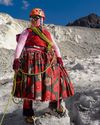
A late morning in Khartoum. Inside a low, dusty building in the centre of the Sudanese capital, there are crates of artefacts, a 2.1-metre replica of a 2,000-year-old stone statue of a Nubian god and students rushing through the corridors. Outside is noisy traffic, blinding sunlight and both branches of the Nile.
Heading down one staircase are Sabrine Jamal, Nadia Musa, Athar Bela and Sabrine al-Sadiq, all studying archaeology at Khartoum University. Not one of them is older than 24 and they see themselves as pioneers, breaking new ground on a continent that has long attracted western expeditions, specialists and adventurers but whose own archaeologists have received less attention overseas.
"It is very important that Africans do African archaeology... because then we will have our own archaeological cultures. There is a lot we understand because we are from here. The idea that people from the west know best is changing," said Sadiq.
Jamal, 22, from the remote and wartorn South Kordorfan province, said stereotypes promoted by films and literature in the west were out of date.
"There is an idea of what an archaeologist looks like ... But they should not have a certain image or colour or features or gender," she said.
For decades, the popular image of archaeologists in Africa has been at odds with an increasingly diverse reality. Dr Ghalia Garelnabi, the acting director of Sudan's national museum, said that when she was at university 30 years ago there were only three women studying archaeology, and now there were 20.
"This is a very great change and an important one. There are more and more young women in Sudan who are interested to know about their history and they deserve to know this ... Twelve years ago we had only foreign missions working here, but this is changing. Now we have many Sudanese missions digging at our sites," Garelnabi said.
Bu hikaye The Guardian Weekly dergisinin January 06, 2023 sayısından alınmıştır.
Start your 7-day Magzter GOLD free trial to access thousands of curated premium stories, and 9,000+ magazines and newspapers.
Already a subscriber ? Giriş Yap
Bu hikaye The Guardian Weekly dergisinin January 06, 2023 sayısından alınmıştır.
Start your 7-day Magzter GOLD free trial to access thousands of curated premium stories, and 9,000+ magazines and newspapers.
Already a subscriber? Giriş Yap

The Saudi football World Cup is an act of violence and disdain
Well, that's that then. In the event there were only two notes of jeopardy around Fifa's extraordinary virtual congress last week to announce the winning mono-bids, the vote without a vote, for the right to host the 2030 and 2034 football World Cups.

AI has made the move into video and it's worryingly plausible
I recently had the opportunity to see a demo of Sora, OpenAI's video generation tool, which was released in the US last Monday, and it was so impressive it made me worried for the future.

With tyrant Assad ousted, Syrians deserve support and hope
Last week, time collapsed. Bashar al-Assad's fall recalled scenes across the region from the start of the Arab spring almost 14 years ago. Suddenly history felt vivid, its memories sharpened. In fact it no longer felt like history.

TV
The Guardian Weekly team reveals our small-screen picks of the year, from the underground vaults of post-apocalyptic Fallout to the mile-high escapism of Rivals

Albums
Murky love stories, nostalgic pop and an in-your-face masterpiece captured our critics' ears in 2024

Film
Visual language, sound, light and rhythm are to the fore in the best movies of the year

Hidden delights Our 24 travel finds of 2024
Guardian travel writers share their discoveries of the year, from Læsø to Lazio

'It's really a disaster' The fight to save lives as gang war consumes capital
Dr James Gana stepped out on to the balcony of his hospital overlooking a city under siege. \"There's a sensation of 'What's next?'. Desperation is definitely present,\" the Médecins Sans Frontières (MSF) medic said, as he stared down at one of scores of camps for displaced Haitians in their country's violence-plagued capital.

Trailblazers The inspiring people we met around the world this year
From an exuberant mountaineer to a woman defiantly facing the guns of war, here are some of the brave individuals who gave us hope in a tumultuous 2024

Votes of confidence
From India to Venezuela and Senegal to the US, more people voted this year than ever before, with over 80 elections across the world. With rising authoritarianism and citizen-led resistance revealing its vulnerabilities and resilience in the face of unprecedented challenges, has democracy reached its breaking or turning point?